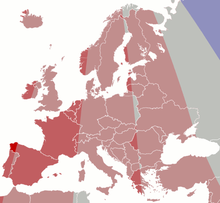
| Light Blue | Western European Time / Greenwich Mean Time (UTC) |
| Blue | Western European Time / Greenwich Mean Time (UTC) |
| Western European Summer Time / British Summer Time / Irish Standard Time (UTC+1) | |
| Red | Central European Time (UTC+1) |
| Central European Summer Time (UTC+2) | |
| Yellow | Eastern European Time / Kaliningrad Time (UTC+2) |
| Ochre | Eastern European Time (UTC+2) |
| Eastern European Summer Time (UTC+3) | |
| Green | Moscow Time / Turkey Time (UTC+3) |
| Turquoise | Armenia Time / Azerbaijan Time / Georgia Time / Samara Time (UTC+4) |
▉▉▉ Dark colours: Summer time observed
Europe spans seven primary time zones (from UTC−01:00 to UTC+05:00), excluding summer time offsets (five of them can be seen on the map, with one further-western zone containing the Azores, and one further-eastern zone spanning the Ural regions of Russia and European part of Kazakhstan). Most European countries use summer time and harmonise their summer time adjustments; see Summer time in Europe for details.
The time zones actually in use in Europe differ significantly from uniform zoning based purely on longitude, as used for example under the nautical time system. The world could in theory be divided into 24 time zones, each spanning 15 degrees of longitude. However, due to geographical and cultural factors, it is not practical to divide the world so evenly, and actual time zones may differ significantly from those based purely on longitude. In Europe, the widespread use of Central European Time (CET) causes major variations in some areas from solar time. Based on solar time, CET would range from 7.5 to 22.5°E. However, for example Spain (almost entirely in the Western hemisphere) and France (almost entirely west of 7.5°E, as illustrated in the map below) should theoretically use UTC, as they did before the Second World War.[1] The general result is a solar noon which is much later than clock noon, and later sunrises and sunsets than should theoretically happen. The Benelux countries should also theoretically use GMT.
Russia and Belarus observed "permanent summer time" between March 2011 and October 2014.[2] Since October 2014 Russia has observed "permanent winter time". Iceland can be considered to be on "de facto" permanent summer time because, since 1968, it has used UTC time all year, despite being located more than 15° west of the prime meridian. It should therefore be located in UTC−01:00, but chooses to remain closer to continental European time, resulting in legal times significantly in advance of local solar time; this is of little practical significance owing to the wide variations in daylight hours in that country.
The European Commission proposed in September 2018 ending the observance of summer time in the EU.[3] In March 2019, the European Parliament voted in favour of proposing ending seasonal clock changes in 2021.[4] Legislation of the EU is decided by both the Parliament and the Council of the European Union, and the Council had not made its decision.[5] Each Member State had until April 2020 to decide whether to remain permanently on their previous "summer time" or their "winter time".

| Colour | Legal time vs local mean time |
|---|---|
| 1 h ± 30 m behind | |
| 0 h ± 30 m | |
| 1 h ± 30 m ahead | |
| 2 h ± 30 m ahead |

| Colour | Legal time vs local mean time |
|---|---|
| 1 h ± 30 m behind | |
| 0 h ± 30 m | |
| 1 h ± 30 m ahead | |
| 2 h ± 30 m ahead | |
| 3 h ± 30 m ahead |
- ^ Poulle, Yvonne (1999). "La France à l'heure allemande" [France on German time] (PDF). Bibliothèque de l'école des chartes (in French). 157 (2): 493–502. Archived from the original (PDF) on 4 September 2015. Retrieved 11 January 2012.
- ^ Parfitt, Tom; Meikle, James (25 March 2011). "Think of the cows: clocks go forward for the last time in Russia". The Guardian. Retrieved 5 January 2012.
- ^ "State of the Union 2018: Q&A on the Commission's proposal to put an end to seasonal clock changes", European Commission − Press Release (Strasbourg, 12 September 2018).
- ^ Buckle, Anne (Mar 26, 2019). "European Union Ready to Scrap DST". timeanddate.com. Archived from the original on Oct 12, 2023.
- ^ "Procedure File: 2018/0332(COD)". Legislative Observatory | European Parliament. Archived from the original on Oct 29, 2023.